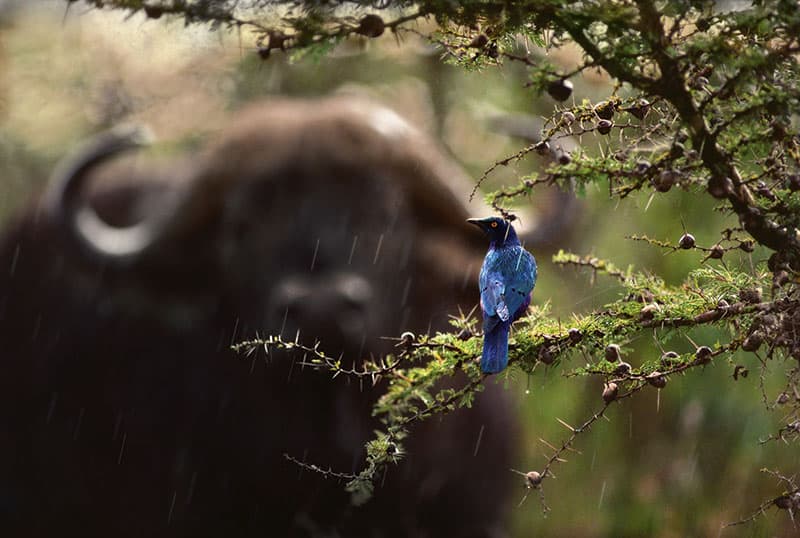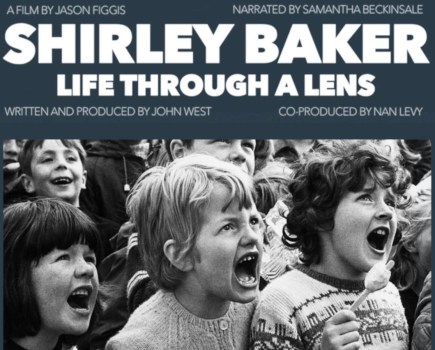Photo Insight with Jim Brandenburg
 For more than 30 years, Jim Brandenburg travelled the world as a photographer with National Geographic magazine. His work has been published in The New York Times, Life and Time, among others, and he has won numerous awards, including Kodak Wildlife Photographer of the Year by the Natural History Museum and BBC Wildlife Magazine. He is the chair of this year’s competition. Every month Jim will share the story behind one of his nature images
For more than 30 years, Jim Brandenburg travelled the world as a photographer with National Geographic magazine. His work has been published in The New York Times, Life and Time, among others, and he has won numerous awards, including Kodak Wildlife Photographer of the Year by the Natural History Museum and BBC Wildlife Magazine. He is the chair of this year’s competition. Every month Jim will share the story behind one of his nature images
This photograph of a glossy starling and a Cape buffalo was one that I came across quite by accident. My reason for being in the location was not to capture the shot, but when I saw it I instantly knew it was an image worth taking. I was on assignment in Kenya during the 1980s, working for National Geographic, where I was tasked with the slightly intimidating role of photographing rhinos. I was there to document the fact that rhinos were becoming an endangered species as a result of poaching for their horns.
On these kinds of trips you don’t tend to do a lot of walking. Most travelling time is spent within the relative safety of a Land Rover. We were driving along and suddenly it started to rain. I peered out of the window and saw the scene you see here. I didn’t have much time to think about it, although I wasn’t under as much pressure as I have been with some shots I’ve talked about in this column.
Before the auto functions of digital technology, we old-time photographers had to be ready for any shot that presented itself. We had to know our exposures and focus manually. We didn’t have time to fiddle with the settings. With today’s cameras, you can just shoot and shoot. For the photograph here, I would have already set my exposure, as the light would have been fairly consistent throughout the environment. I would have used Kodachrome ISO 64 film and a Nikon 300mm f/2.8 lens, which I used a lot on my shoots in those days.
With this in mind, photographers are often haunted by a number of ghosts. Let’s call them the ones that got away. The majority of photographs are once-in-a-lifetime opportunities and each image is unique, communicating something about that exact moment that no other photograph can. However, not all potential photographs are realised. Perhaps events took place too fast or the photographer simply wasn’t ready. Think about all the potentially great photographs that never happened because the photographer was not quick enough or was too preoccupied with their exposure. You must always be prepared.

This image combines many elements for me, some of which function on the subliminal level. There’s a beauty about the gentle, delicate bird and the soft rain that is covering the scene. Then there is the thorny tree coupled with one of the most dangerous animals in Africa just out of focus in the background. You have contradictions here: the gentle and the savage, the beautiful and the foreboding. I often like to do this with my images, to bring together several contradictory elements of nature. Often, they’ll line up within a shot in a kind of serendipity that has followed me throughout my career.
On a more basic level, I really like the composition and I particularly like the fact that it breaks the rules. One of my bugbears with a lot of the images I see these days – and it’s something that affects students in particular – is a reliance on the rules. People will study photography and have these ideas and rules drilled into them, such as things have to be cropped right, everything has to be sharp and you have to follow the Rule of Thirds. I like the fact that the Cape buffalo is out of focus yet it still manages to be intimidating. It should go without saying that rules are made to be broken. Rules offer a false comfort and you can only learn and develop your photographic knowledge through following your own path.
I may be mistaken, but it’s my understanding that buffalo are one of the most dangerous creatures in Africa – perhaps the most dangerous. More people are attacked by this animal than any other in the country as the buffalo have very short tempers. Most people seem to see the buffalo as a cow, and for that reason they aren’t too afraid of them, but people need to understand that they have a fearsome reputation for a reason – they charge first and ask questions later.
I have a great deal of affection for this picture, although few people have wanted to publish it. It’s very rare that it’s picked out of my collection. I wouldn’t go so far as to say that it’s a great photograph, but it’s definitely one that sticks out in my mind. I held a retrospective recently where I showed some of my favourite images, but this photograph wasn’t included. Yet something about this picture sticks with me. It makes me smile, and that’s one of the best things that you can say about an image.
Jim Brandenburg was talking to Oliver Atwell
To see more of Jim’s images visit www.jimbrandenburg.com







